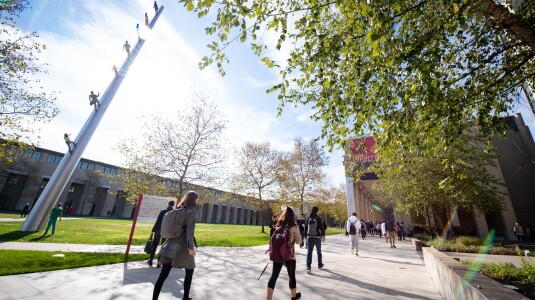The COVID-19 pandemic introduced a new, dynamic environment that made predictions of all kinds more complex and challenging. At Amazon, this uncertainty touches on everything from the supply chain to customer spending habits to workforce availability.

In her role on the automated inventory management (AIM) team in the Supply Chain Optimization Technologies (SCOT) organization, Amazon Scholar Tatevik Sekhposyan helps to guide researchers and scientists as they consider the effects of a vast set of economic variables and the uncertainty around them to help Amazon predict inventory more accurately.
Inventory predictions help Amazon prepare for fluctuations in capacity and workforce needs and can also help identify opportunities to improve the supply chain.
“Identifying which variables matter, why they matter, and how to model their relationship to each other is how I help,” she said.
The importance of better predictions stretches far beyond Amazon.
“At any level, be it an individual, a firm, a bank, or a government organization, decision-making is based on how sure of an outcome we are,” Sekhposyan explained. “There are questions of budget and resource allocation, and decisions about what course to take depend on just this.”
Her research explores the uncertainty in predictions and its implications for the economy.
For example, the upheaval of the COVID-19 pandemic caused economies to fluctuate on very short time scales, but traditional economic statistics such as GDP, inflation, and unemployment are typically reported only monthly or quarterly and with lags, leaving economists without timely data on economic health. Sekhposyan investigated whether non-traditional, higher-frequency variables could provide more rapid readouts and found that electricity consumption could be used to monitor the economy in near-real time.
Sekhposyan uses the scenarios she encounters at Amazon as inputs for discussion in her courses on economic forecasting and applied econometrics.
As Amazon customers, her students often see things from a consumer perspective, but through her work with SCOT’s AIM team, Sekhposyan offers a different vantage point.
“My association with Amazon helps me bring my understanding of the demands of the private sector to the classroom. Ultimately, we must prepare our students for real-world challenges,” she said.
Taking an interest in uncertainty
Sekhposyan’s interest in economics arose from her personal experience.
She grew up in Armenia, and shortly after it gained independence from the Soviet Union, she spent a year as an exchange student in the US. Although she didn’t fully comprehend the economic challenges Armenia was facing then, the stark contrast between the economic systems in the two countries was hard to ignore.
“I really wanted to understand why some countries were in such different situations than others,” she said.
She pursued post-graduate education in the US, ultimately receiving her PhD in economics from the University of North Carolina at Chapel Hill. An economic recession during that period helped her realize that most economic models could only handle “regular times, with low volatility” and could not explain the impacts of big shocks like recessions.
“The non-linearities had to be entertained in these models to make them more relevant,” she said.
After graduating, she went on to work at the central Bank of Canada, where she worked extensively on characterizing uncertainty and its macroeconomic effects. She later joined Texas A&M University, where she has the chance to conduct her own research and to inspire students’ interest in economics.
“We need to show students successful professionals in economics. They need to see role models to pursue this field,” she said.
Sekhposyan also mentors junior researchers as president of the Society of Nonlinear Dynamics and Econometrics, which promotes the analysis of nonlinearity in economics for both theoretical and real-world applications.
“I truly enjoy getting to know the new generation of economists and the exciting work they do,” said Sekhposyan.
Uncertainty applied in the real world
Sekhposyan became an Amazon Scholar in 2021, in part for the opportunity to work with other accomplished experts.
Domenico Giannone, a SCOT senior principal economist, stands out to Sekhposyan. “Not only is he a great economist, he is also a super helpful mentor and such a positive spirit! He is one of the reasons I got interested in working with Amazon. I always get to learn a lot from him,” she said.
Tatevik also partners closely with several members of SCOT’s science community, including Eric Sperber, a senior data scientist who also focuses on inventory predictions.
“There really are so many great scientists at Amazon. I’m always so impressed by the ideas I hear in my meetings,” she said.
Working at Amazon also keeps Sekhposyan focused on aspects of uncertainty that matter in a corporate setting. Accounting for that uncertainty can improve predictions and, in turn, decisions.
Sekhposyan uses travel demand as an example: “Predicting travel demand can tell us how much luggage, for example, we should stock.” But making accurate predictions remains a huge challenge in the wake of the COVID-19 pandemic.
“We need to understand how spending patterns are going to change because of our experience with COVID. How have our habits changed and for how long?”
Economists like Sekhposyan are essential in answering these questions.
“This is what economists bring to the table: the ability to explain predictions and the uncertainty around them,” she said.
And increasingly, economics graduates are following her lead and applying their skills in non-traditional enterprises like tech, retail, and litigation.
“I love the flexibility this field offers,” Sekhposyan said. “There are so many ways to be successful.”





















